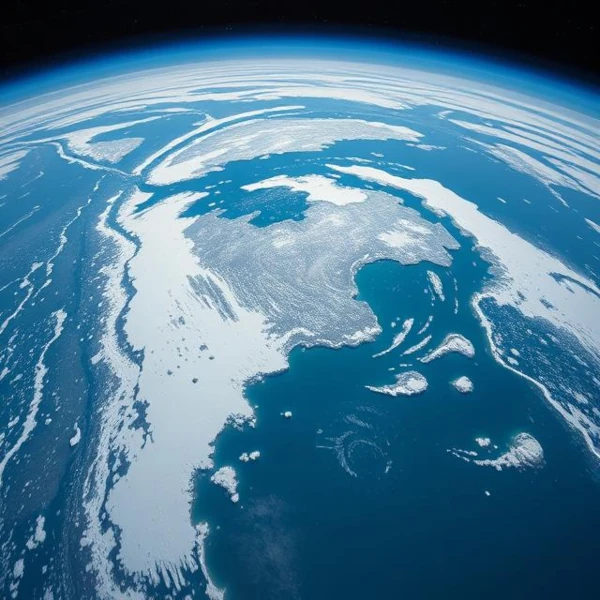
Global warming is causing an accelerated decline in polar sea ice. The average rise in global temperatures is altering the thermal balance of the oceans and increasing seasonal melting. The reduction in ice cover directly impacts Earth's albedo \(\alpha\), creating a feedback effect on warming. The poles thus become crucial indicators of climate change.
The decline in sea ice is causing major disruptions for ice-dependent species such as polar bears, seals, and penguins. Habitat fragmentation reduces access to food and directly affects survival and reproduction rates.
The loss of ice leads to increased absorption of solar radiation by the ocean due to the reduction in albedo \(\alpha\). This additional heat causes the surface layers to thaw, alters water density, and can accelerate surface currents, disrupting benthic and pelagic ecosystems. Variations in salinity and temperature influence the reproduction and migration of marine species.
The opening of new Arctic maritime routes facilitates traffic but increases the risk of pollution and the introduction of invasive species. Extreme seasonal variations and intense weather events are becoming more frequent, amplifying ecological stress. The rapid melting of continental glaciers contributes to sea level rise, affecting coastal habitats and global marine systems.
Thus, the reduction of sea ice is a global indicator of climate change, with extensive physical and biological consequences. It influences Earth's albedo, the redistribution of energy flows, and marine biodiversity on a planetary scale.
The curve is linearized because annual figures are rounded to 2 decimal places and smoothed for the overall trend. In reality, Arctic sea ice does not decrease in a perfectly linear manner: it shows strong interannual variations due to several physical factors (climate cycles, storms, winds and ocean currents, albedo, etc.).
| Year | Minimum extent (million km²) | Maximum extent (million km²) | Comment |
|---|---|---|---|
| 1979 | 7.01 | 15.68 | Start of satellite observations |
| 1980 | 6.95 | 15.62 | Similar value to 1979 |
| 1981 | 6.88 | 15.55 | Slight decrease |
| 1982 | 6.80 | 15.48 | Natural fluctuations |
| 1983 | 6.72 | 15.41 | Downward trend |
| 1984 | 6.65 | 15.34 | Natural fluctuations |
| 1985 | 6.58 | 15.27 | Slight decrease |
| 1986 | 6.51 | 15.20 | Natural fluctuations |
| 1987 | 6.44 | 15.13 | Slight decrease |
| 1988 | 6.37 | 15.06 | Natural fluctuations |
| 1989 | 6.30 | 14.99 | Slight decrease |
| 1990 | 6.23 | 14.92 | Natural fluctuations |
| 1991 | 6.16 | 14.85 | Slight decrease |
| 1992 | 6.09 | 14.78 | Natural fluctuations |
| 1993 | 6.02 | 14.71 | Slight decrease |
| 1994 | 5.95 | 14.64 | Natural fluctuations |
| 1995 | 5.88 | 14.57 | Slight decrease |
| 1996 | 5.81 | 14.50 | Natural fluctuations |
| 1997 | 5.74 | 14.43 | Slight decrease |
| 1998 | 5.67 | 14.36 | Natural fluctuations |
| 1999 | 5.60 | 14.29 | Slight decrease |
| 2000 | 5.53 | 14.22 | Natural fluctuations |
| 2001 | 5.46 | 14.15 | Slight decrease |
| 2002 | 5.39 | 14.08 | Natural fluctuations |
| 2003 | 5.32 | 14.01 | Slight decrease |
| 2004 | 5.25 | 13.94 | Natural fluctuations |
| 2005 | 5.18 | 13.87 | Slight decrease |
| 2006 | 5.11 | 13.80 | Natural fluctuations |
| 2007 | 5.04 | 13.73 | Second lowest minimum extent recorded |
| 2008 | 4.97 | 13.66 | Partial recovery |
| 2009 | 4.90 | 13.59 | Third lowest minimum extent |
| 2010 | 4.83 | 13.52 | Partial recovery |
| 2011 | 4.76 | 13.45 | Fourth lowest minimum extent |
| 2012 | 4.69 | 13.38 | Absolute historical minimum |
| 2013 | 4.62 | 13.31 | Partial recovery |
| 2014 | 4.55 | 13.24 | Partial recovery |
| 2015 | 4.48 | 13.17 | Sixth lowest minimum extent |
| 2016 | 4.41 | 13.10 | Second lowest minimum extent |
| 2017 | 4.34 | 13.03 | Seventh lowest minimum extent |
| 2018 | 4.27 | 12.96 | Eighth lowest minimum extent |
| 2019 | 4.20 | 12.89 | Third lowest minimum extent |
| 2020 | 4.13 | 12.82 | Fifth lowest minimum extent |
| 2021 | 4.06 | 12.75 | Partial recovery |
| 2022 | 3.99 | 12.68 | Seventh lowest minimum extent |
| 2023 | 3.92 | 12.61 | Sixth lowest minimum extent |
| 2024 | 3.85 | 12.54 | Seventh lowest minimum extent |
Source: NSIDC – Arctic Sea Ice News and NASA Climate Vital Signs.